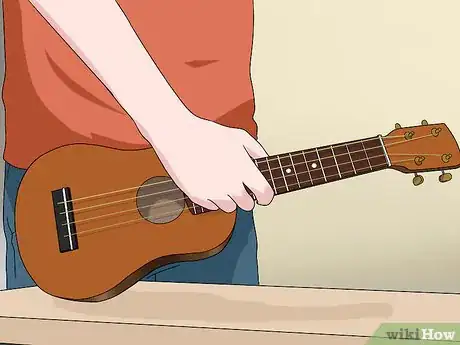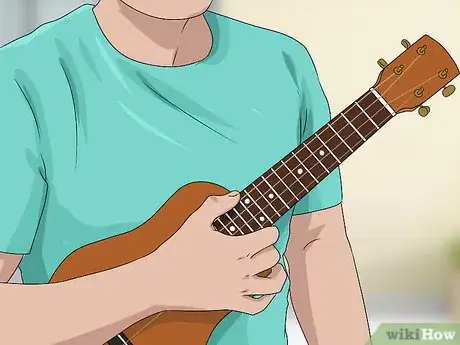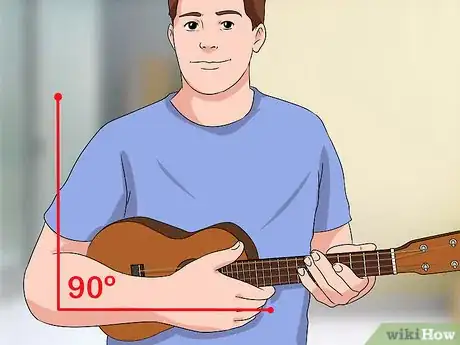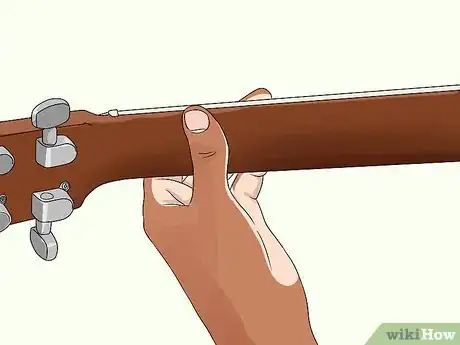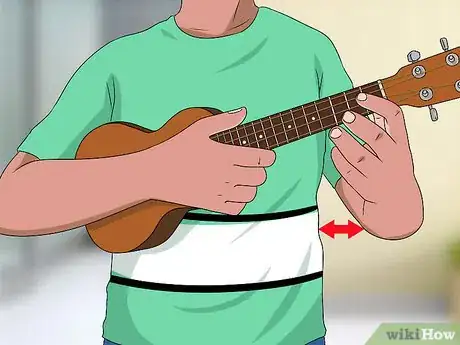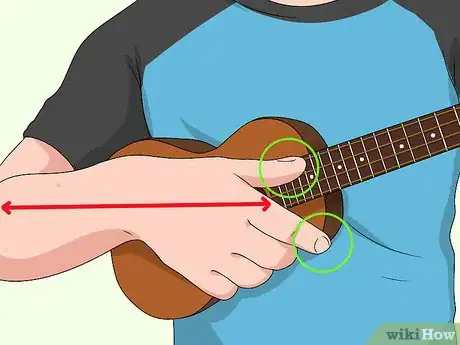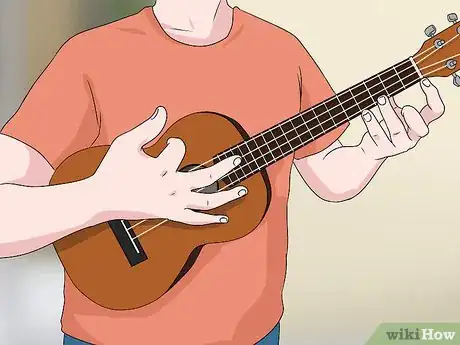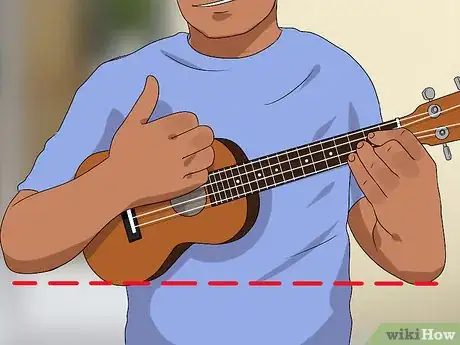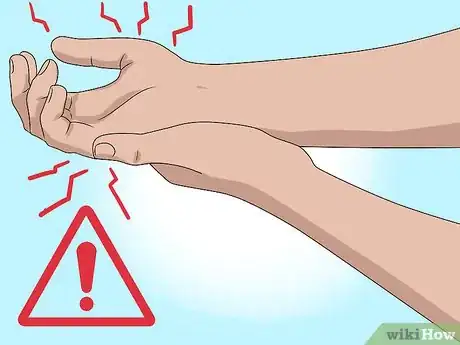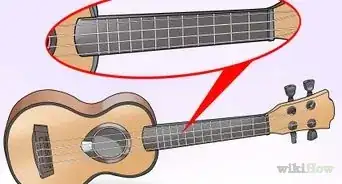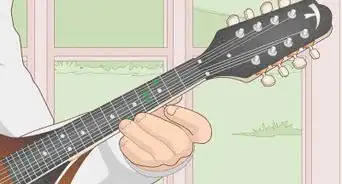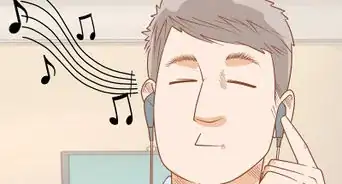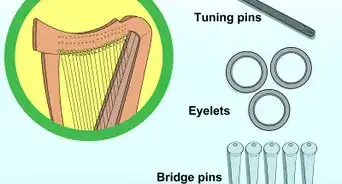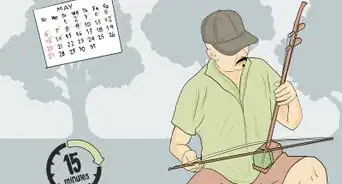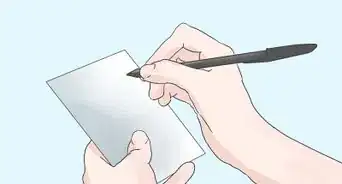This article was co-authored by wikiHow Staff. Our trained team of editors and researchers validate articles for accuracy and comprehensiveness. wikiHow's Content Management Team carefully monitors the work from our editorial staff to ensure that each article is backed by trusted research and meets our high quality standards.
There are 10 references cited in this article, which can be found at the bottom of the page.
wikiHow marks an article as reader-approved once it receives enough positive feedback. In this case, 90% of readers who voted found the article helpful, earning it our reader-approved status.
This article has been viewed 80,180 times.
Learn more...
The ukulele is a small and delightful instrument that is simple to learn. Before you can play, however, you must learn how to hold the instrument properly. You should always support a ukulele by cradling the body, not by grasping the neck. Other than that, the most important rule is that it feels comfortable and easy for you! You can always adjust the hold to fit your needs.
Steps
Using a Traditional Position
-
1Pick up the ukulele with your right hand. The best place to grab it is where the neck meets the body. Wrap your right hand around the front of the ukulele to grasp it.[1]
- For beginners, the right hand will be the hand that you strum the strings with, regardless of which hand is your dominant hand.[2]
-
2Press the ukulele to your chest. If this is uncomfortable, try moving it slightly higher or lower. The ukulele should be parallel to the ground, although the neck may be held up at a slight angle.[3]Advertisement
-
3Cradle the body of the ukulele with your right arm. Keep your elbow at a 90-degree angle. The end of the ukulele should press against your forearm. If the ukulele slips, hold it a little tighter. Don't squeeze the ukulele too tightly, however. You need just enough pressure to keep the ukulele in place.[4]
- Keep holding the ukulele between the neck and body until your left hand is in place.
-
4Place the thumb of your left hand behind the neck. Put it between the nut (or the top of the frets) and the third fret. Wrap the rest of your fingers around the front of the neck so that your fingers are parallel to the fret. Let your fingers float above the frets. Only your fingertips should touch the neck.[5]
- The left arm should not hold the weight of the ukulele. Do not grasp the neck. A light touch will let you move your fingers more freely up and down the frets.
-
5Hold your left elbow away from your body. Do not keep it tucked in or pressed against your side. Instead, keep it out a few inches from your body. There should be a straight line from your elbow through your wrist.[6]
- Keep your wrist straight as you hold the ukulele. For some difficult chords, you may need to twist your wrist, but in most cases, the wrist will stay straight.
-
6Extend your right hand along the bottom of the ukulele. Keep your wrist straight, but let your fingers cup the bottom of the instrument. You can use your thumb or index finger to strum.
- Some people strum over the sound hole while others will strum between the neck and the body. Whichever method you choose, make sure your hand can comfortably reach it.
Using Variations
-
1Play with your left hand if it is more comfortable. While most people play the ukulele with their right hand, you can play the ukulele with your left hand. In this case, you will hold and strum the ukulele with your left hand and play the frets with your right hand. Keep in mind that most ukulele instruction books are written for right-handed players, so you may need to reverse any instructions you use.[7]
- If you do not want to constantly reverse playing instructions, you can restring your instrument so that the G-string is the top string when you hold the instrument with your left arm.
-
2Rest the ukulele on your leg if you are sitting. To play in this position, turn the ukulele so that the neck is held up at an angle. This may help if you are playing a larger ukulele or if you are a beginner.[8]
-
3Remove your strumming hand from the ukulele if you are advanced. After a while, you may no longer need to support the ukulele by holding it on the bottom. Instead, support the ukulele entirely with your forearm. Float your wrist over the sound hole to strum. This will give you more movement.[9]
- If you cannot hold the ukulele this way without it slipping, you may not be ready to try this.
-
4Use a strap to help support the ukulele while standing. The strap will keep the ukulele in place to let you play with more ease. You can use a ukulele strap or an adjustable guitar strap. These are available at instrument stores and online.[10]
- Ukulele straps are usually not needed if you are playing in a seated position.
Checking Your Position
-
1Move 1 hand away to see if the ukulele stays in place. Try it first with your fretting hand and then with your strumming hand. You should sit in a chair to do this. If the ukulele slips, you need to hold it tighter. If it stays put, you're holding it correctly.
- Always have at least one hand on the ukulele. Only let go of one hand at a time.
-
2Keep your elbow at a right angle. If the ukulele starts to slip, check your elbow position to see if it is causing the problem. Your strumming elbow should always be held at a 90-degree angle. Avoid pressing either elbow too close to your body.[11]
-
3Practice fingering the chords. You should be able to comfortably reach all chords while holding the ukulele. Try playing a few simple chords. If your hands feel tired after a few minutes or if the tone is muted, you may be gripping the neck too tightly.[12]
- You should never have to stretch or strain to reach a chord or to strum. If you do, adjust where you place your hands on the neck or body of the ukulele.
-
4Relax if you start to cramp. If your hands, arms, or wrists start aching after a few minutes, you may be too tense. Check that your wrists are straight. Put down the ukulele to help you release any tension in your shoulders, arms, or neck. Try again once you are loose and relaxed.[13]
- If you feel any pain or discomfort, your body is trying to tell you something! You can develop wrist strain if you are not holding the ukulele properly, so always adjust your position if you feel tense, achy, or uncomfortable.[14]
Community Q&A
-
QuestionHow come when I search 'ukulele' on wikiHow, this doesn't come up?
 Community AnswerYou could've spelled the word incorrectly or maybe you weren't specific enough.
Community AnswerYou could've spelled the word incorrectly or maybe you weren't specific enough. -
QuestionCan I use a guitar pick for a ukulele?
 Community AnswerYou could, but most people don't. Using it could take away from the common light sound that the ukulele makes.
Community AnswerYou could, but most people don't. Using it could take away from the common light sound that the ukulele makes. -
QuestionWhat's the difference between a soprano and a baritone ukulele?
 RubyTop AnswererA soprano ukulele is the most common type. It's higher-pitched and is a small one, which makes it harder to play for those with bigger fingers. A baritone ukulele is the biggest type of ukulele, has the lowest pitch and is good for guitar players crossing over. The tenor and concert ukuleles are in between and are also an option. What ukulele you get depends on you and what you want from it.
RubyTop AnswererA soprano ukulele is the most common type. It's higher-pitched and is a small one, which makes it harder to play for those with bigger fingers. A baritone ukulele is the biggest type of ukulele, has the lowest pitch and is good for guitar players crossing over. The tenor and concert ukuleles are in between and are also an option. What ukulele you get depends on you and what you want from it.
Warnings
- Keep your wrists straight but relaxed to prevent wrist strain as you play the ukulele.⧼thumbs_response⧽
References
- ↑ https://www.youtube.com/watch?v=EezlTrZ7QV0&feature=youtu.be&t=140
- ↑ https://liveukulele.com/lessons/how-to-hold-an-ukulele/
- ↑ https://www.youtube.com/watch?v=EezlTrZ7QV0&feature=youtu.be&t=154
- ↑ http://artistworks.com/blog/how-to-play-the-ukulele-standing-up
- ↑ https://liveukulele.com/lessons/how-to-hold-an-ukulele/
- ↑ https://liveukulele.com/lessons/how-to-hold-an-ukulele/
- ↑ https://liveukulele.com/lessons/how-to-hold-an-ukulele/
- ↑ https://www.youtube.com/watch?v=EezlTrZ7QV0&feature=youtu.be&t=235
- ↑ https://www.youtube.com/watch?v=BKZK8vjDx2Q&feature=youtu.be&t=31
About This Article
To properly hold a ukulele, use your right hand to hold the instrument where the neck meets the body. Press the ukulele to your chest so it’s parallel to the ground or tilted up at a slight angle. Cradle the body of the ukulele with your right arm, and place the thumb of your left hand behind the neck, with your left elbow held slightly away from your body. Once the ukulele is secure, use the fingers on your left hand to press down the strings on the neck, and strum the strings with your right hand. Keep reading to learn how to play the ukulele left-handed!
